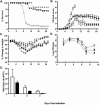A severe acute respiratory syndrome-associated coronavirus-specific protein enhances virulence of an attenuated murine coronavirus
- PMID: 16103185
- PMCID: PMC1193615
- DOI: 10.1128/JVI.79.17.11335-11342.2005
A severe acute respiratory syndrome-associated coronavirus-specific protein enhances virulence of an attenuated murine coronavirus
Abstract
Most animal species that can be infected with the severe acute respiratory syndrome-associated coronavirus (SARS-CoV) do not reproducibly develop clinical disease, hindering studies of pathogenesis. To develop an alternative system for the study of SARS-CoV, we introduced individual SARS-CoV genes (open reading frames [ORFs]) into the genome of an attenuated murine coronavirus. One protein, the product of SARS-CoV ORF6, converted a sublethal infection to a uniformly lethal encephalitis and enhanced virus growth in tissue culture cells, indicating that SARS-CoV proteins function in the context of a heterologous coronavirus infection. Furthermore, these results suggest that the attenuated murine coronavirus lacks a virulence gene residing in SARS-CoV. Recombinant murine coronaviruses cause a reproducible and well-characterized clinical disease, offer virtually no risk to laboratory personnel, and should be useful for elucidating the role of SARS-CoV nonstructural proteins in viral replication and pathogenesis.
Figures






References
-
- Bergmann, C. C., Q. Yao, M. Lin, and S. A. Stohlman. 1996. The JHM strain of mouse hepatitis virus induces a spike protein-specific Db-restricted CTL response. J. Gen. Virol. 77:315-325. - PubMed
-
- Chinese SARS Molecular Epidemiology Consortium. 2004. Molecular evolution of the SARS coronavirus during the course of the SARS epidemic in China. Science 303:1666-1669. - PubMed
Publication types
MeSH terms
Substances
Grants and funding
LinkOut - more resources
Full Text Sources
Molecular Biology Databases
Miscellaneous

